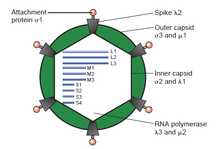Mammalian orthoreovirus
Examples of these are: upper respiratory tract syndromes, gastroenteritis (stomach flu), biliary atresia, obstructive hydrocephalus, jaundice, alopecia, conjunctivitis, and ‘oily hair’ associated with steatorrhea.
Meaning, that a human infected with Mammalian orthoreovirus, regardless of the serotype, is nearly or completely asymptomatic, and therefore, don't exhibit signs or symptoms of the virus.
This is because the Mammalian orthoreovirus is a double stranded RNA virus, and as stated previously, a part of the Reovirus family.
This is based on the fact that viruses within this subfamily, such as the Mammalian orthoreovirus, Aquareovirus, Coltivirus, Cypovirus, etc., have the presence of a turreted protein on the inner capsid.
[5][7] The etymology of the Mammalian orthoreovirus is based upon “ortho-“ translated from Greek as “straight” and “reovirus“ from respiratory enteric orphan virus.
Serum surveys conducted in the 1950s found neutralizing antibodies to mammalian orthoreovirus in humans, monkeys, rabbits and guinea pigs.
The division is based upon fusogenic orthoreoviruses having the ability to cause fusion of infected cells, resulting in multinucleated cellular syncytia.
Serotypes 1 (Lang), 2 (Jones), and 3 (Dearing) were originally recognized based upon virus neutralization and hemaglutination-inhibition profiles.
The Mammalian orthoreovirus double stranded RNA genome contains 10 segments divided into three size classes (small, medium, and large) based upon their characteristic mobility during gel electrophoresis.
Because of the nature of double stranded RNA, double stranded RNA viruses such as reoviruses, and the Mammalian orthoreovirus must carry and/or encode the necessary enzymes within their virions in order to first transcribe their genome, producing mRNA, and delivering their infectious mRNA into the cytoplasm of the host cell.
In the outer capsid layer, the proteins take part in the role of environmental stability, and cell attachment to a number of hosts, which are quite variable even within the same Orthoreovirus genus.
[6][7][10] Once inside the person the Mammalian orthoreovirus attaches to target cells via the σ1 protein, a filamentous trimer that protrudes from the outer capsid layer.
Sialic acid, resident within the respiratory system of most mammals is a co-receptor for Mammalian orthoreovirus Type 3 (Dearing).
[7][11][13][14] Mammalian orthoreovirus messenger RNA transcripts have a short 5’ untranslated region, and do not have 3’ poly A tails, some lack 5’ caps during post-infection.
Examples include, pigs, cattle, horses, primates, dogs, cats, rabbits, mice, marsupials, and humans.


